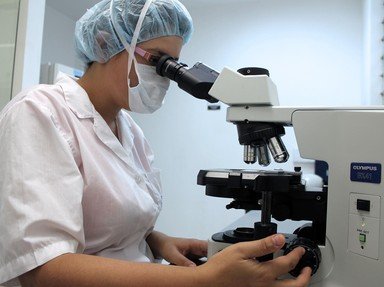Quiz Answer Key and Fun Facts
1. Ion channels are a versatile group of membrane proteins that can be opened by various stimuli such as ligand binding. Once open, ions move through these channels. The direction these ions move is determined by the concentration of the ions either side of the membrane, as well as by a second factor. What is this second factor?
2. Cells use membrane proteins to protect themselves from bursting. This is done by water-specific pores, which allow the rapid flow of water molecules across the cell membrane. What are these important proteins called?
3. Membrane proteins are not just used as portals into and out of the cell. Proteins known as integrins act as anchors and assist cellular motility. What is the name of the surrounding environment to which integrins bind?
4. While integrins are involved in attaching cells to the surrounding environment, a second type of membrane protein is involved in attaching cells to other cells. Which protein, with varieties called E, N, and VE, are important in cell-cell adhesion and may become lost during metastasis?
5. Another class of membrane protein is the pump. These proteins use energy to transport ions (or other substances) against their electrochemical gradient. They are important for maintaining nerve function and in acidification of specific organelles. What ubiquitous molecule do these pumps utilise as their energy source?
6. A second group of energy-using membrane proteins are the ABC transporters. Perhaps the best characterised ABC transporter is called Pgp, which exports hydrophobic molecules such as drugs out of cells. Why may Pgp's activity be a problem?
7. Another set of membrane proteins involved in transport are those which transport one species of ion against its concentration gradient by utilising a pre-existing concentration gradient of a second ion species. What is this type of protein called?
8. Signals outside of the cell are detected by receptors, which then bring about an effect in the cell. One membrane protein that is involved in signalling is adenylyl cyclase, which produces a molecule known as cAMP. What term is used to describe molecules such as cAMP which transmit signals within cells?
9. Many substances which we are familiar with, such as insulin, bind to this next group of membrane proteins. Ligand binding induces dimerization and allows a signal to be sent to the cell. What name, which refers to a key amino acid, is given to these proteins?
10. One of the most intriguing groups of membrane proteins are the G-protein coupled receptors (GPCRs). These proteins make up around 50% of conventional drug targets and can help to explain how we smell, taste and feel. Which of the following is an example of a GPCR?
Source: Author
doublemm
This quiz was reviewed by FunTrivia editor
WesleyCrusher before going online.
Any errors found in FunTrivia content are routinely corrected through our feedback system.
